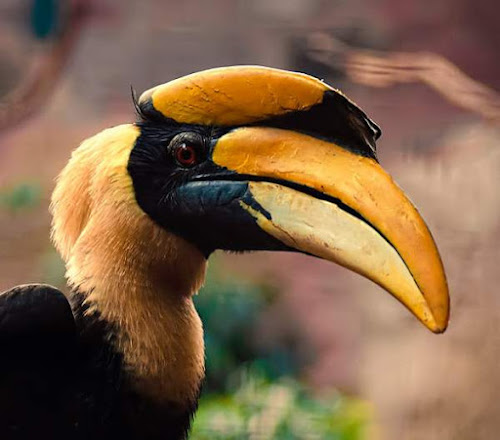The great hornbill (Buceros bicornis) is a pied Asian hornbill belonging to the family Bucerotidae and genus Buceros.
These Buceros sp. are also known as concave-casqued hornbill, giant hornbill and Indian hornbill. These species are distributed exclusively in south and southeast Asian countries. These Buceros sp. are monotypic species. The distribution of these species is fragmented in India. These birds are state birds of Kerala and Arunachal Pradesh in India.
The total population of individual birds is estimated to be between 13,000 to 27,000 mature individuals. In China it has become a rare resident. Though in India it is considered to be fairly common, there is rapid decline in the population.
In Indonesia, recently these birds have become uncommon due to devastation of the island's lowland forests. In Vietnam, Cambodia and Malaysia it has become uncommon to rare. There is also decline in the populations of these species in Myanmar and Thailand.
 |
| 1.Great hornbill photos by Kalyanvarma |
 |
| 2.Great hornbill photo by Steve Wilson |
 |
| 3.Great hornbill photo by N. A. Naseer |
 |
| 4.Great hornbill photo by Monish Matthias |
 |
| 5.Buceros bicornis photo by N. A. Naseer |
 |
| 6.Buceros bicornis photo by Angadachappa |
 |
| 7.Buceros bicornis photo by Lip Kee |
 |
| 8.Buceros bicornis by tontantravel |
 |
| 9.Buceros bicornis by Navaneeth Kishor |
 |
| 10.Buceros bicornis by Dr. Raju Kasambe |
These birds are hunted for their flesh, beaks and head. The flesh is considered to have medicinal properties and young birds are considered delicacy. The head, beak and feathers are worn as decorations by several tribal communities. Adult and juvenile hornbills are trapped for pet trade and many nesting sites are abandoned due to human disturbance.
1.Photo source: https://commons.wikimedia.org/wiki/File:Great-Hornbill.jpg
Photo author: Kalyanvarma | License: CC BY-SA 3.0
2.Photo source: https://commons.wikimedia.org/wiki/File:Pleased_to_meet_you_(10400572063).jpg
Photo author: Steve Wilson | License: CC BY 2.0
3.Photo source: https://commons.wikimedia.org/wiki/File:Great_Hornbill_(female)_by_N.A._Nazeer.jpg
Photo author: N. A. Naseer / www.nilgirimarten.com / naseerart@gmail.com | License: CC BY-SA 2.5 IN
4.Source: https://commons.wikimedia.org/wiki/File:HornbillCouple.jpg
Author: Monish Matthias | License: CC BY-SA 4.0
5.Source: https://commons.wikimedia.org/wiki/File:Pied_Hornbill_2_by_N_A_Nazeer.jpg
Author: N. A. Naseer / www.nilgirimarten.com / naseerart@gmail.com | License: CC BY-SA 2.5 IN
6.Source: https://en.wikipedia.org/wiki/File:Female_Great_Hornbill_carrying_food.jpg
Author: Angadachappa | License: CC BY-SA 4.0
7.Source: https://www.flickr.com/photos/lipkee/449256940/
Author: Lip Kee | License: CC BY-SA 2.0 as on 3/22/17
8.Source: https://www.flickr.com/photos/tontantravel/8360432509/
Author: tontantravel | License: CC BY-SA 2.0 as on 3/22/17
9.Source: https://commons.wikimedia.org/wiki/File:Great_Indian_Hornbill_Buceros_bicornis.jpg
Author: Navaneeth Kishor | License: CC BY-SA 4.0
10.Source: https://commons.wikimedia.org/wiki/File:Great_Pied_Hornbill_Buceros_bicornis_by_Dr._Raju_Kasambe_(2).jpg
Photo author: Dr. Raju Kasambe | License: CC BY-SA 4.0
Current topic in Birds of India: Great hornbill (Buceros bicornis) photos.